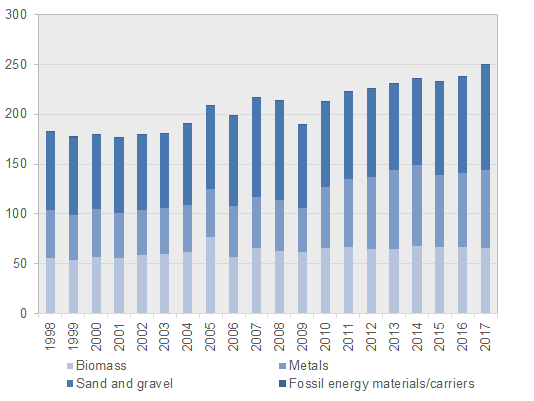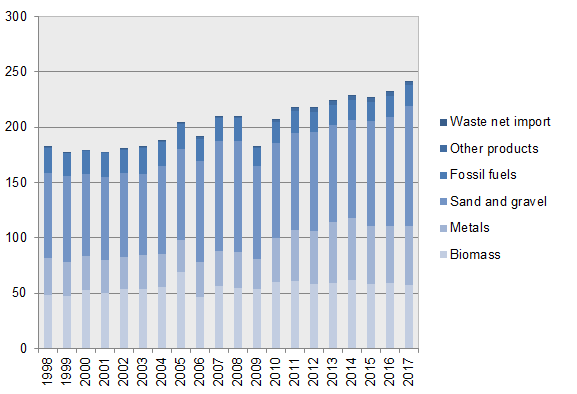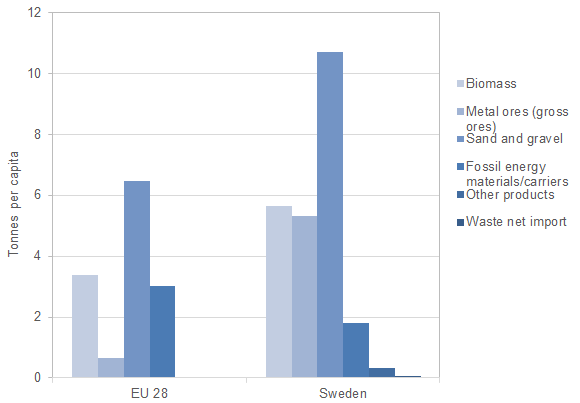Environmental accounts - Economy-wide material flow accounts 1998–2017
Swedish extraction of natural resources increased sharply
Statistical news from Statistics Sweden 2018-12-12 9.30
Natural resource extraction has continued to increase since 1998. In Sweden, 250 million tonnes of natural resources were extracted and material consumption amounted to 242 million tonnes, which is 23.9 tonnes per person.
Significant quantities of natural resources extracted every year in Sweden are used domestically or are exported. In 2017, 250 million tonnes were extracted, which is the highest rate since the beginning of the time series in 1998 and is an increase of 13 million tonnes, or 5 percent, compared with 2016. Sand and gravel was the largest subcategory, with 96 million tonnes extracted in 2017 and accounted for the bulk of the increase. Timber is the second largest subcategory in material flow, 37 million tonnes extracted in 2017. This is followed by metal ores, such as iron ore (32 million tonnes), copper ore (24 million tonnes), and gold and silver ore (20 million tonnes). There is rising extraction trend in sand and gravel and metal ores, while for timber, the trend is relatively unchanged. Certain events leave clear impressions in the statistics, such as the storm Gudrun, which led to a temporary large increase in timber extraction in 2005, and the international financial crisis, which led to a sharp decline in most categories in 2009 due to falling demand.

Source: Environmental Accounts, Statistics Sweden
Domestic material consumption
Domestic material consumption is defined as domestic extraction plus import, minus export. Total domestic material consumption has increased by 4 percent since 2016 and by 33 percent since 1998, and amounted to 242 million tonnes in 2017. Consumption is greatest in the sand and gravel category, at 109 million tonnes in 2017, up by 10 percent since 2016 and by 40 percent since 1998. Consumption of metals has increased by 63 percent since 1998 and by 5 percent since 2016. Consumption of fossil fuels has decreased by 3 percent since 2016 and by 18 percent since 1998 and amounted to 18 million tonnes in 2017. However, consumption was even lower in 2009 and in 2013–2015, which means there is no decreasing trend in recent years. The categories “other products” and “waste” have increased considerably since 1998, albeit from low levels. In 2017, consumption of other products was 3 million tonnes and waste amounted to 0.8 million tonnes.

Source: Environmental Accounts, Statistics Sweden
Sweden compared to the EU
Comparison with other countries is made practical when material consumption per person is reported. In 2017, material consumption per person was 23.9 tonnes in Sweden, while the EU average was only 13.6 tonnes per person. This gap has increased since 2008, when domestic material consumption per person was 22.6 tonnes in Sweden and 16.5 tonnes in the EU.
In Sweden, material consumption per person is higher for biomass (5.7 tonnes compared to the EU average of 3.4 tonnes), metals (5.3 tonnes compared to the EU average of 0.7 tonnes), non-metallic minerals (10.7 tonnes compared to the EU average of 6.5 tonnes), and the small categories “other products” and “waste”. On the other hand, material consumption per person of fossil fuels is lower in Sweden (1.8 tonnes) compared to the EU average (3.0 tonnes).
The differences between Sweden and the EU average can be explained by the fact that Sweden has a large area and a relatively sparse population, which leads to higher natural resource use per person. In an international perspective, Sweden has large metal deposits. Forests cover a large part of Sweden’s area, and most of the forests are managed, which gives large quantities of timber. A large part of Sweden’s energy supply comes from hydropower, nuclear power and biofuels which decreases the need for fossil fuels, compared to the EU average.
Sweden’s extraction of natural resources per person is higher than the EU average. Countries with limited natural resources tend to have higher import levels. This means that the level of domestic material consumption is lower because imported goods are often value added and weigh less than the original material. This may explain why the EU average is so much lower than Sweden’s consumption level.

Source: Environmental Accounts, Statistics Sweden
Definitions and explanations
The consumption of natural resources can be monitored in the system of economy-wide material flow accounts (EW-MFA). One of the main indicators of the EW-MFA is domestic material consumption (DMC), which measures the amount of material extracted in the country, plus imports minus exports.
Material flows are divided into the following main material categories: biomass, metals, non-metallic minerals (mainly sand and gravel), fossil fuels, other products and waste. These are further divided into about 40 subcategories.
The EW-MFA is used to measure the resource productivity of a country’s economy, and to examine the relationship between resource consumption and the GDP in comparisons between different countries’ environmental performance. For instance, the DMC indicator is used in the EU Roadmap to a Resource Efficient Europe (see link below).
Since 2013, the EW-MFA is included in the EU regulation on environmental accounts (see link below), which means EU Member States are obliged to report statistics on their material flows to the EU.
Next publishing will be
2019-12-05 at 09:30
Statistical Database
More information is available in the Statistical Database
Feel free to use the facts from this statistical news but remember to state Source: Statistics Sweden.
